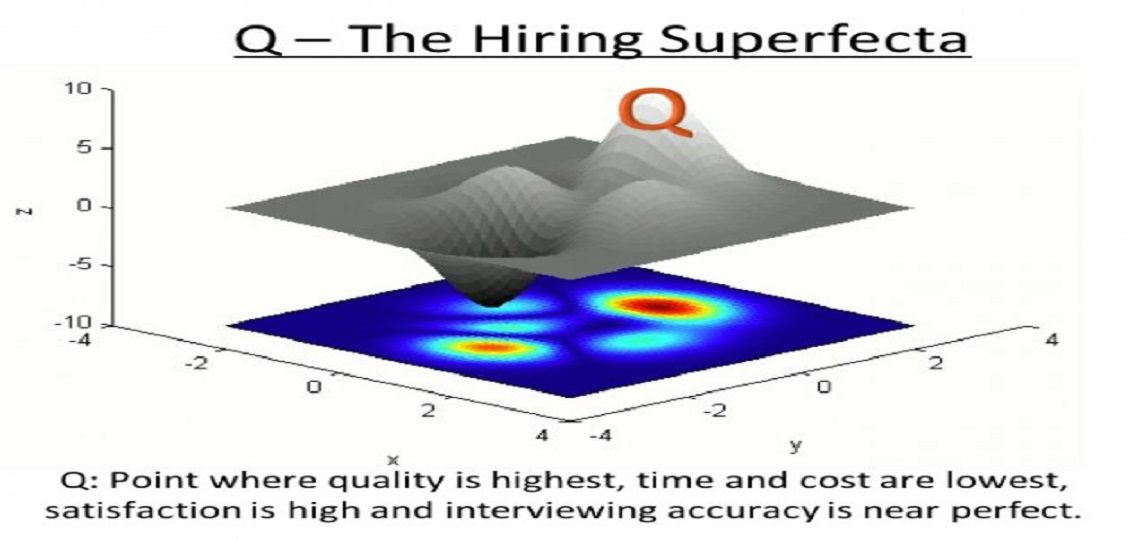Hiring a great person is not easy. There are just too many variables to consider. However, if you do the math, you’ll discover that the best jobs and the best people are at point “Q” in Peter Yu’s cool graph. This is the optimum hiring decision where cost is reasonable, quality is highest, time to fill is short, interview accuracy is about perfect and the job is a great move for the candidate.


Achieving “Q” represents the superfecta of hiring where everybody wins: The hiring manager, the candidate, the recruiter and the company .
The first step in getting to “Q” is classifying job seekers into one of these four primary buckets:
The known: People you know personally.
As long as the job is similar, interviewing accuracy would will be high and time to fill is fast for people you know and who are available. However, they might not be the best people for the job. These people frequently get hired for the wrong reasons, typically the pressure to fill the job is more important than their ability to do excel in it.
The semi-known: The people who are well- known by people who are well-known to you.
In networking terms these second degree connections are called “weak connections.” This is the sweet spot for top talent. By asking people whom you know, “Who are the best people you know doing (describe the real job)?” you’ll find a few great people. Of course, you’ll need to recruit these people since it’s unlikely they’ll be actively looking for a new job. However, if you can hire these people in a timely fashion AND they find the job a true career move, getting to “Q” will be possible.
The less- well- known: The people who are well-known by someone you could get to know.
By connecting to co-workers in your company whom you don’t know, you’ll be able to tap into a huge source of top talent. For example, to find top engineers connect with product marketing managers working in a related field. Using LinkedIn Recruiter you can then search on their connections to “cherry pick” some ideal prospects. Then ask the product managers to qualify the person and ask if the person would find the job a career move. If so, contact and recruit these people. This adds some time to the process but they represent a great pool of talent for achieving “Q.”
The unknown: The people who typically respond to job postings who are not connected to anyone in your company.
There are too many unknowns with this unknown group to easily get to “Q.” While you shouldn’t discount the best of this group, don’t spend too much time here since they often take extra time to find and the assessment accuracy is less predictable.
Getting Closer to “Q”
In terms of achieving a state of “Q,” it’s pretty clear that the best candidates are those who are your connections’ connections. However, this doesn’t mean that the open job represents a career move for the person. This is the next step in the process.
Maximize job satisfaction and performance.


A career move for any top tier person needs to provide a 30% non-monetary increase. As shown in the the graphic this consists of some combination of a bigger and/or more important job, a mix of more satisfying work plus faster growth. None of this can be figured out using traditional skills-laden job descriptions.
When I take a search assignment I ask the hiring manager to define the work as a series of performance objectives. For example, “Lead the development of a driverless lawn tractor using state-of-the art satellite-based GPS in combination with GLisp and AI.” During the interview I dig into the person’s comparable accomplishments to determine if the person can do the work, is motivated by it and if the job offers a 30% non-monetary increase. Obviously if the person can do the work he/she has all of the skills necessary. Using this type of performance-based interview is how you maximize interviewing accuracy, improve job fit and increase quality of hire.
Achieving “Q”
As long as you first prepare a roadmap – the performance-based job description – finding “Q” is a realistic objective. However, without knowing what the person needs to do to be successful you’ll never arrive. From a sourcing perspective you’ll then need to spend most of your time getting referrals of the semi-knowns – your connections’ connections. Too often we hire people we know despite their flaws since it’s fast and easy or hire the best person who applies.
However, if you resist the temptation to take shortcuts you’ll arrive at “Q.” The people you hire will be the best available, they’ll be highly satisfied and perform at peak levels, interviewing accuracy will be insane, and you’ll reduce time to hire to the lowest level possible. That’s the superfecta of hiring. You don’t even need to do the math.
Permission has been granted from The Adler Group and Lou Adler, author of Hire With Your Head and The Essential Guide to Hiring & Getting Hired, to reprint this article.
About the author
Lou Adler is the CEO and founder of The Adler Group – a training and search firm helping companies implement Performance-based Hiring℠. Adler is the author of the Amazon top-10 best-seller, Hire With Your Head (John Wiley & Sons, 3rd Edition, 2007). His most recent book has just been published, The Essential Guide for Hiring & Getting Hired (Workbench, 2013). He is also the author of the award-winning Nightingale-Conant audio program, Talent Rules! Using Performance-based Hiring to Build Great Teams (2007). Adler holds an MBA from the University of California in Los Angeles and a BS in Mechanical Engineering from Clarkson University in New York.









































